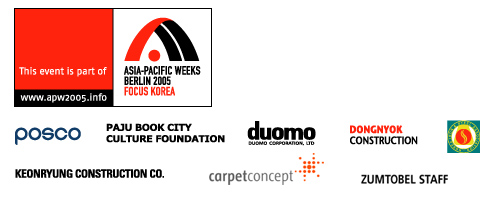Paju Book City, Korea
The exhibition is embedded within the Asia-Pacific-Weeks 2005 in Berlin, of which Korea is the focal point.
For more information about the architects look under: www.PBCexhibition.net
The Paju Book City (PBC) planned as a city for print-media, combines modern architecture and human environment with economic and infrastructural requirements.
The PBC complex was constructed recently along the northern part of the Han River near Seoul on a site measuring 150 ha commissioned by the Cooperative of Paju Book City.
Located a half-hour drive northwest of Seoul, this site aims to function as a self-sufficient metropolis capable of covering every step of the publishing process - from publishing, distribution, printing, bookbinding and design to papermaking and copyright negotiations. The Paju Publishing Culture Information Industrial Complex, commonly known as Paju Book City, opened in 2003, is poised today to become the center of South Korea's publishing culture in the 21st century.
The Korean architects Seung H-sang and Kim Young-joon as coordinators directed the entire project. The Graduate School of Environment of Seoul National University developed the basic masterplan. The urban landscape concept was lead by Florian Beigel at North London University / Architecture Research Unit (ARU). Planed and built projects had to follow a design guideline set by a core team of Florian Beigel, Min Hyun-sik, Seung H-sang, Kim Jong-kyu and Kim Young-joon.
Basing its decisions on the master plan, the design board in charge of the project proposed several domestic and international architects for each building lot.
The individual owners, publishing houses or related industries either accepted these proposals or chose their own architects, whose designs were subject to approval of the design board.
While the owners of the individual buildings are responsible for their designs, the overall aesthetics of the cityscape are being carefully managed.
Buildings, for example, are to be no more than four stories high. Walls between lots are forbidden, as is ostentatious signage.
Paju Book City has turned out to be an outstanding and remarkable example of synergy between conceptual program, human environment, modern architecture, as combined with economic and infrastructural requirements.
Worldwide, it would be difficult to find a comparable contemporary industrial development.
Another nickname that has become attached to the Paju Book City is "Eco-City." This name reflects the vision of the complex as a city designed to exist in harmony with nature and even to evolve through time - artificial though it may seem, in the sense of being planned and built from scratch.
A stream flows through the center of the complex, attracting cranes and other migratory birds. This is indeed an eco-friendly city.
The exhibition will cover aspects of urban form and new spatial organization, while highlighting the unique character of Korean architecture as applied to urbanism and the city. The show is designed to offer a wide public insight into Korea’s urban culture by featuring new architectural projects and their conceptually diverse backgrounds.
A large model will represent Paju Book City, by photographs of realized buildings, drawings of planned projects, and smaller models.
The exhibition will also serve to introduce the Korean and international architects who are participating in the project.
Participating architects are:
Florian Beigel, Suh Hailim + Kim Junsung, Chang Yung-ho, Kim Young-sub, Kwon Moon-sung, Manuel Gausa, Choi Moon-gyu, Jang Yoon-gyoo, Woo Kyung-kook, Yi Jong-ho, Kim Seung-hoy, Choi Du-nam, Min Hyun-sik, E Il-hoon, Kim Jong-kyu, Joh Sung-yong, Sejima Kazuyo + Nishizawa Ryue, Choi Wook, Seo Hyun + Cemong Architecs, Kim Kwang-hyun, Kim In-cheurl, Cho Min-suk + Park Ki-su, Kim Won, Lee Min-ah + Daniel Valle, Stan Allen, Kim Byung-hyun, Bang Chul-rin, Chung Guyon, Kim Hyo-man, Kishi Waro, Alexandro Zaera-Polo + Farshid Moussavi, Xaveer de Geyter, Kim Bong-ryol + Kang Seung-hee, Vicente Guallart, Kim Byung-yoon, Kim Young-joon.
Project manager at Aedes: Ulla Giesler / Isolde Nagel
For further information and photos please contact
www.aedes-arc.de/pressedownload and
www.pbcexhibition.net
The exhibition is connected to the exhibition ‘Culturescapes / Seung H-Sang, Seoul’, which will be shown at Aedes East at the same period and will be opened on the same date.
An Aedes catalogue will be published {€10.-).
Diese Ausstellung wurde ermöglicht mit der großzügigen Unterstützung von:
